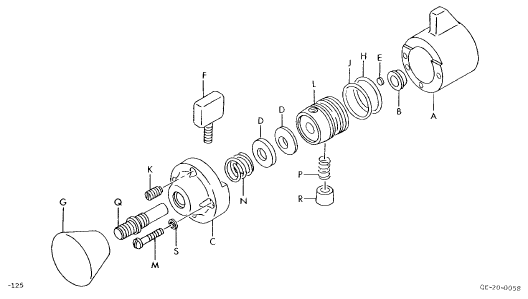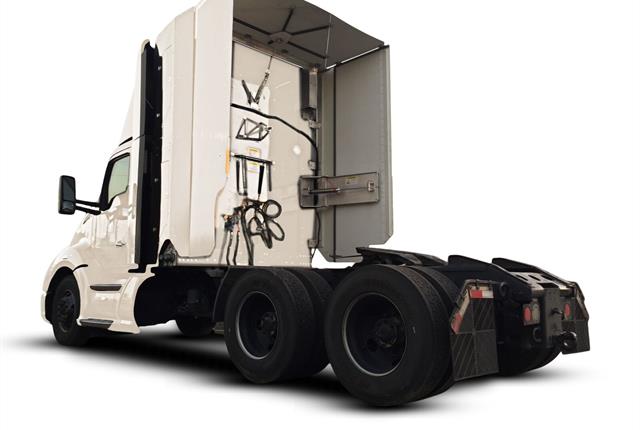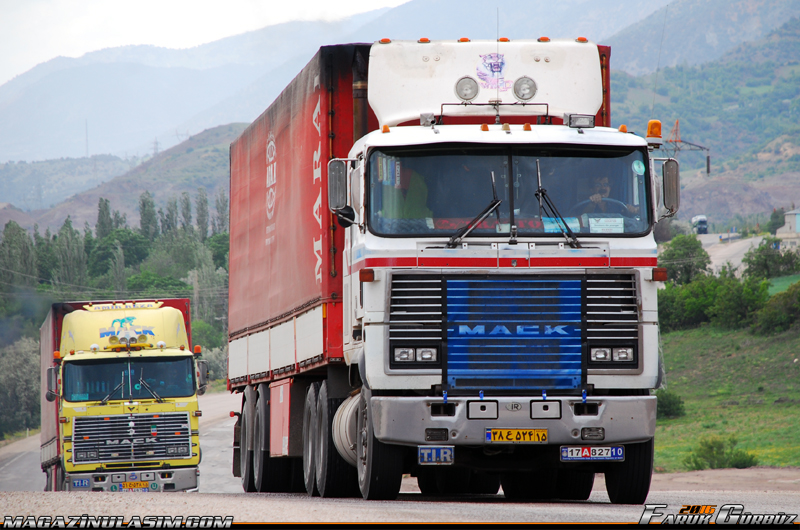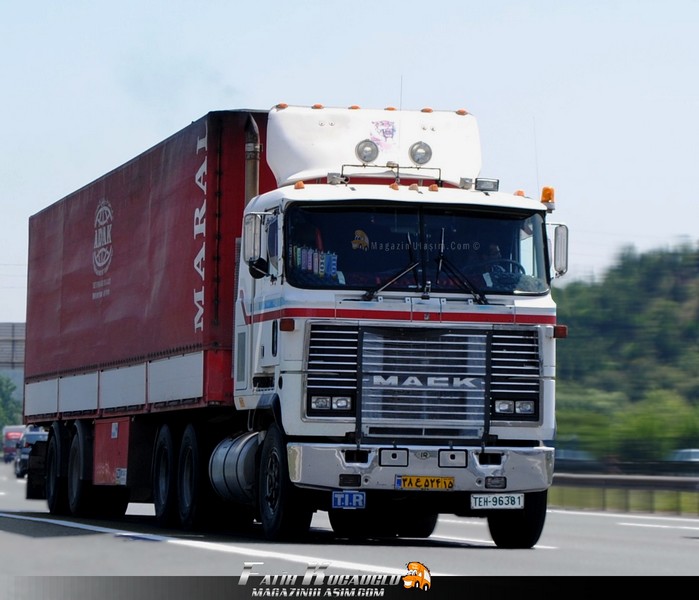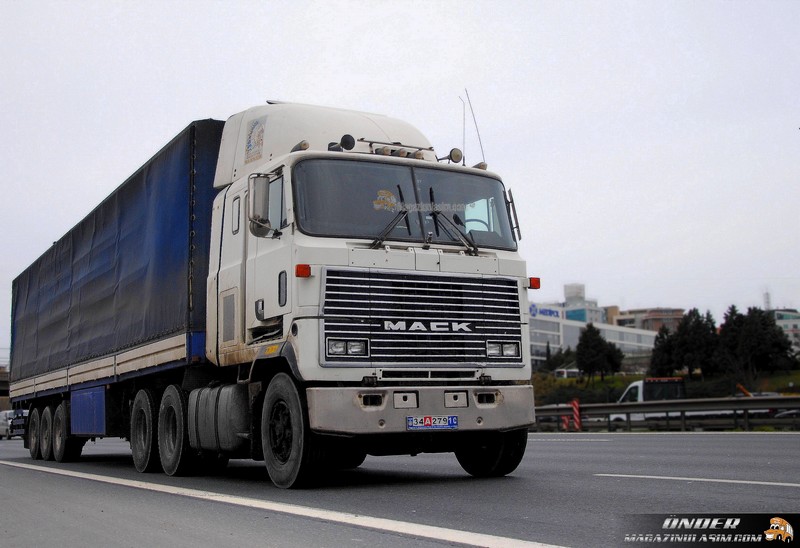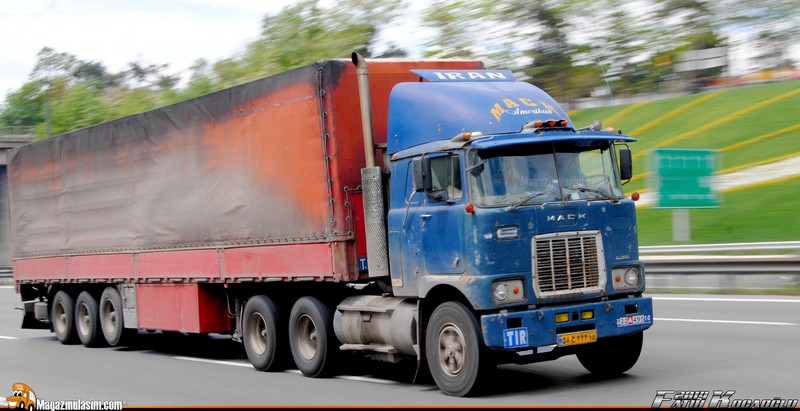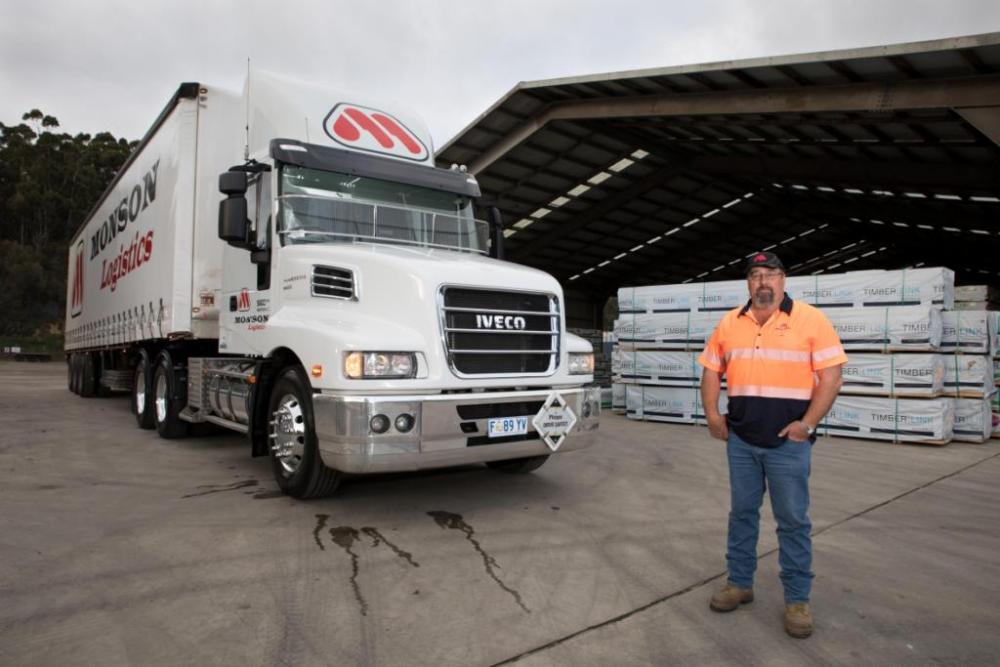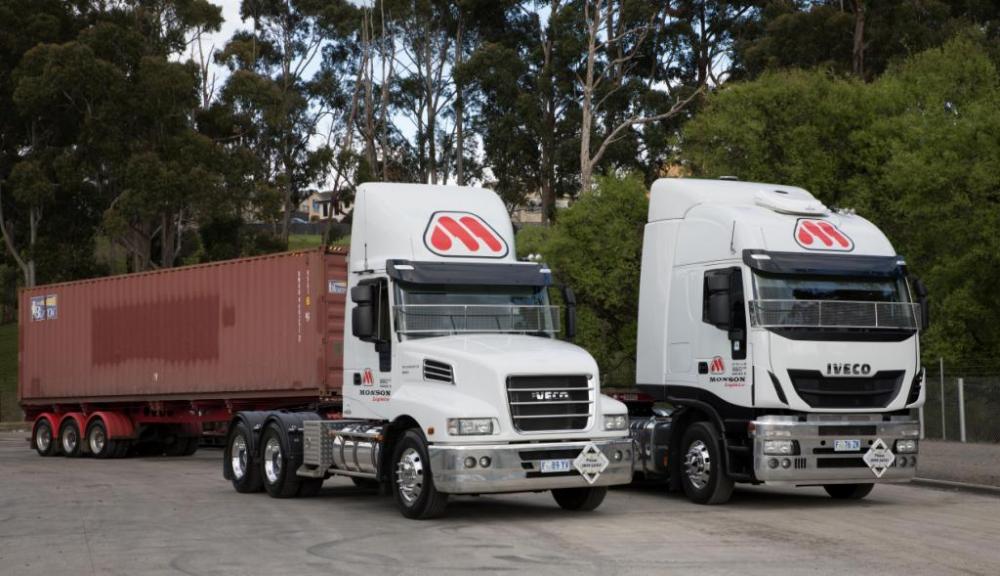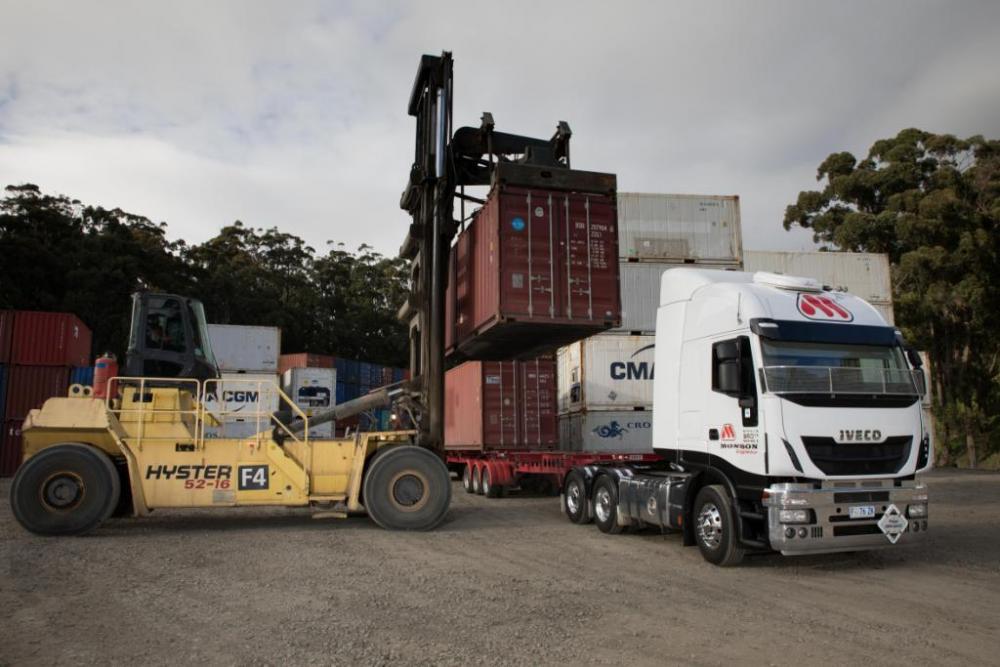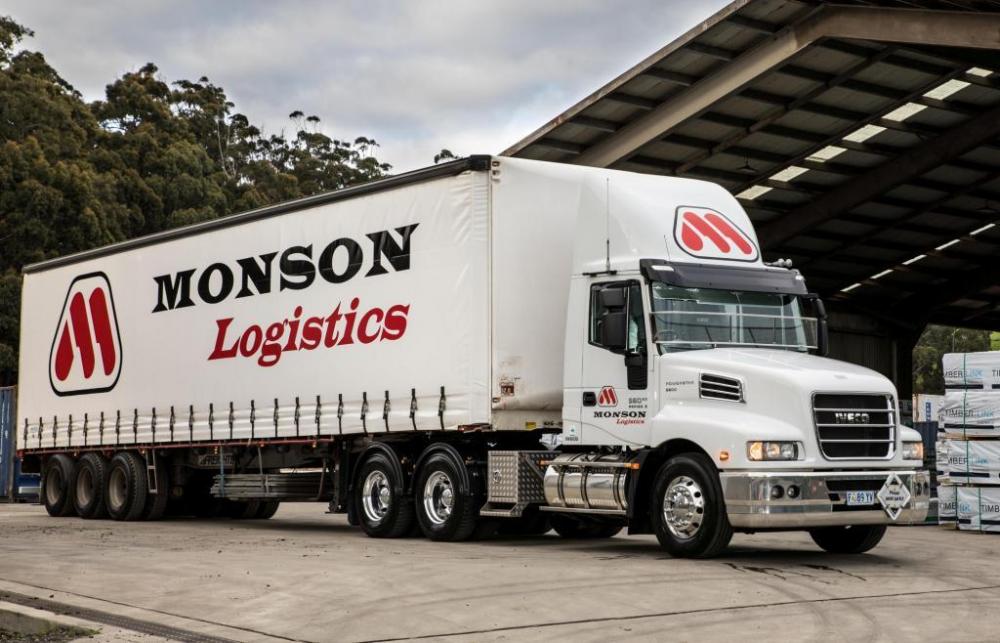
kscarbel2
Moderator-
Posts
17,893 -
Joined
-
Days Won
86
Content Type
Profiles
Forums
Gallery
Events
Blogs
BMT Wiki
Collections
Store
Everything posted by kscarbel2
-
It's simply a matter of fact that the former Mack Trucks had the best part numbering system of any truckmaker in the world. And today in year 2017, nobody has surpassed it.
-
-
Scania Group Press Release / November 13, 2017 When Ohara Corporation decided to upgrade its range of snow groomers for the first time in two decades, it wanted an engine capable of delivering low emissions and noise without sacrificing torque. Most engine suppliers winced at the complexity of the task. In Japan, snow requires a gentle touch. The country’s ski slopes sit at a lower altitude than in Europe or the United States, leaving the snow more humid and powdery. The air is kept pristine by one of the world’s strictest emissions regulations, passed in 2015. Well-proven technology “The new emissions regulations in Japan has really raised the bar,” says Minoru Baba, Assistant Chief of Vehicle Design at Ohara Corporation. “We checked with quite a few engine suppliers. We saw that Scania’s engines had passed European standards, which are similar to those in Japan, and we knew they worked well in winter conditions.” Ohara was already using Scania engines in its Arctic exploration vehicles, which have to meet the toughest environmental standards going. Pleased with the results, the company decided to remodel its mid-range snow groomer around a 9-litre 350 hp Scania engine. “We already had new features for the upgrade, so once we got the Scania engine into place things progressed smoothly,” says Baba during a break in testing the new model, which goes on sale in November. “The passion that Scania had for the task made it easy to work together.” Less maintenance with compact design The engine’s compact design, which doesn’t require a diesel particulate filter, suggests it will also require less service and maintenance – a key factor in sales, Baba says. The result after more than two years of joint effort is a machine that is quieter, faster and more stable than previous models. It is lighter than European groomers and has a rear shredder to help it climb Japan’s narrow slopes and smooth out lumps of ice. As the sun rises, Baba climbs back into the enlarged three-person cabin. Unlike in rival machines, the driver sits in the middle in a low-backed seat that makes descents more comfortable. Snow grooming is tough work. Japanese operators drive for up to eight hours a day, often starting their shift at 2 am. They need a machine that is nimble and easy to use, yet reliable and modern. “I wanted to make the kind of machine that I’d like to ride,” Baba says. The engine Ohara Corporation chose the Scania 9-litre 350 hp engine because it combined high torque with low emissions and noise levels. Low maintenance costs could be an added bonus. Related reading – https://www.oharacorp.co.jp/en/products/snowvehicles/ .
-
I was always told that the drum (cylinder) was a non-serviceable part (we didn't sell it separately). But if you purchased it separately in the past, you taught me something!
-
Did you try rebuilding your shift knob with a 14RC1131 repair kit from Watt's Mack ? (Mack part numbers.....simply unforgettable. Try that with a meaningless Volvo global part number.)
-
https://www.bigmacktrucks.com/topic/30165-when-scania-trucks-roamed-north-america/?tab=comments#comment-167688
-
Labor violations force truckers into life of servitude
kscarbel2 replied to kscarbel2's topic in Trucking News
Bernie Sanders Wants Crackdown on Trucking Companies That Don't Pay Living Wage Heavy Duty Trucking (HDT) / November 13, 2017 Sen.Bernie Sanders (I-VT) wants the U.S. government to only provide federal contracts to trucking companies that pay workers a living wage and benefits, he stated in a letter President Trump last week. In the letter, he cites a controversial USA Today report that described the plight of certain independent-contractor drivers working at the Ports of Los Angeles and Long Beach who worked to pay off truck leases and took home little pay. Sanders urged President Trump to sign an executive order that would deny government contracts and subcontracts for trucking companies that misclassify workers as independent contractors, force workers to lease the trucks they drive, and engage in abusive labor practices. Sanders also suggested that the Labor Department audit its current contracts and subcontracts awarded to port trucking companies to ensure they are in compliance with the wage and labor requirements of the McNamara – O’Hara Service Contract Act. “This should not be happening in the United States of America,” Sanders states in the letter. “Truck drivers are the backbone of the American economy. They deserve to be treated with respect and dignity, not like modern-day indentured servants.” Democrats on Capitol Hill have given extra attention to alleged labor and wage abuses at America’s ports since the USA Today expose ran earlier this year. In late October, Rep. Grace Napolitano (D-CA) and Rep. Jerry Nadler (D-NY) introduced two bills aimed at addressing labor and environmental issues at the ports. However, port trucking companies and stakeholders have maintained that the cases outlined in the USA Today story were too extreme and not representative of industry practices. They’ve also characterized it as part of an attempt to unionize labor at the ports by the Teamsters Union. The union has organized several driver strikes at ports over the past few years to protest what it says is a misclassification of drivers as independent contractors in order to forego paying proper wages and benefits. -
Many people know John and yet few "know" John. I feel as though I know him better than many. He's a very unique minded individual. Extremely intelligent, not mainstream.
-
Heavy Duty Trucking (HDT) / November 13, 2017 XStream Trucking has introduced TruckWings, which it calls an “active-aero device” that automatically deploys at highway speeds to deliver streamlined aerodynamics, fuel savings, and lower carbon emissions. According to Daniel Burrows, the company’s founder and CEO, TruckWings features a patented design, that has been developed through years of wind tunnel, track, and road testing and is designed to work at highway speeds. The system automatically deploys large panels to cover the sides and top of the tractor-trailer gap. The panels, which are made of high-impact, glass-reinforced composites, create a continuous connection between the truck and trailer that allows the air to flow smoothly over the entire length of the truck. When the truck slows down, the panels retract without driver intervention, providing the necessary clearance for turns at any angle. “There have been significant investments made in improving truck aerodynamics in other areas,” Burrows said. “TruckWings is the first device which completely solves the turbulence problem created by the open area between the tractor and trailer that contributes significantly to a truck’s overall aerodynamic drag. Since two-thirds of a truck’s fuel bill is spent overcoming that drag, there is a huge savings to be had by reducing it.” "The exciting thing about TruckWings is that it is the first solution to automatically and completely enclose the sides and top of the tractor-trailer gap,” said Mike Roeth, Executive Director of the North American Council for Freight Efficiency, NACFE. “This gap area presents as much as a 5% opportunity with little to no other solutions available for truckers today. We performed their first independent on-road fuel economy test in 2016 and XStream has always taken a very customer led, data-driven product development approach." “We see TruckWings performing particularly well on routes with high winds. Crosswinds push a wedge of air flow into the gap area, hitting the front of the trailer direct on. TruckWings cleanly prevent this buffeting and this is where we see our highest fuel savings.” said Burrows, “Drivers feel the improvement in windy conditions and report much smoother rides with less lane drift.” Burrows said the company is offering several options for truck and fleet owners interested in adding TruckWings to their tractors, including a shared-savings model and outright purchasing. .
-
DHS says 757’s hacked remotely without pilot’s knowledge Aviation News / November 8, 2017 A team of government, industry and academic officials successfully demonstrated that a commercial aircraft could be remotely hacked in a non-laboratory setting last year, a U.S. Department of Homeland Security (DHS) official said Wednesday at the 2017 CyberSat Summit in Tysons Corner, Virginia. “We got the airplane on Sept. 19, 2016. Two days later, I was successful in accomplishing a remote, non-cooperative, penetration,” said Robert Hickey, aviation program manager within the Cyber Security Division of the DHS Science and Technology (S&T) Directorate. “[Which] means I didn’t have anybody touching the airplane, I didn’t have an insider threat. I stood off using typical stuff that could get through security and we were able to establish a presence on the systems of the aircraft.” Hickey said the details of the hack and the work his team are doing are classified, but said they accessed the aircraft’s systems through radio frequency communications, adding that, based on the RF configuration of most aircraft, “you can come to grips pretty quickly where we went” on the aircraft. The aircraft that DHS is using for its tests is a legacy Boeing 757 commercial plane purchased by the S&T branch. After his speech at the CyberSat Summit, Hickey told Avionics sister publication Defense Daily that the testing is with the aircraft on the ground at the airport in Atlantic City, New Jersey. The initial response from experts was, “’We’ve known that for years,’” and, “It’s not a big deal,” Hickey said. But in March 2017, at a technical exchange meeting, he said seven airline pilot captains from American Airlines and Delta Air Lines in the room had no clue. “All seven of them broke their jaw hitting the table when they said, ‘You guys have known about this for years and haven’t bothered to let us know because we depend on this stuff to be absolutely the bible,'” Hickey said. Hickey, who is a staff officer in the Office of the Director of National Intelligence on assignment to DHS S&T, said that while aviation is a subsector of the transportation component of the National Infrastructure Protection Plan, the focus is squarely on traditional terrestrial-based systems. The reservation and scheduling systems of airline aren’t part of Hickey’s research, he said. “I want to suggest to you that there’s a different type of critical infrastructure, and that’s critical infrastructure that’s in motion, of which aviation is one of the third of that,” Hickey said. The others are surface and maritime transportation, he said. “And I look at all of those and say, ‘If we’re not looking at those from a different perspective, we’re going to miss the boat,’ no pun intended,” Hickey said. He said he doesn’t know the answers yet for aircraft cyber infrastructure, adding that it’s not a policy issue yet because more research needs to be done on these systems to understand what the issues are. Patching avionics subsystem on every aircraft when a vulnerability is discovered is cost prohibitive, Hickey said. The cost to change one line of code on a piece of avionics equipment is $1 million, and it takes a year to implement. For Southwest Airlines, whose fleet is based on Boeing’s 737, it would “bankrupt” them if a cyber vulnerability was specific to systems on board 737s, he said, adding that other airlines that fly 737s would also see their earnings hurt. Hickey said newer models of 737s and other aircraft, like Boeing’s 787 and the Airbus Group A350, have been designed with security in mind, but that legacy aircraft, which make up more than 90% of the commercial planes in the sky, don’t have these protections. Aircraft also represent different challenges for cybersecurity and traditional land-based networks, Hickey said. He said that whether it’s the U.S. Air Force or the commercial sector, there are no maintenance crews that can deal with ferreting out cyber threats aboard an aircraft. “They don’t exist in the maintenance world,” Hickey said, noting that when he was in the Air Force, he commanded a logistics group. Hickey was also an airline pilot for more than 20 years. The chief information officers of airlines “don’t know how to chase a cyber spark through an airplane either,” Hickey said. “Why? Because they have been dealing with, and they’re programmed to, and they do a great job of, protecting the terrestrial-based networks. Airplanes are absolutely different — crazy different.” Trying to deal with airplane cybersecurity the same way it is approached for land-based networks “is going to leave us short of the mark,” Hickey said. Hickey's team for his work includes Massachusetts Institute of Technology, the Energy Department's Pacific Northwest National Laboratory, University of California San Diego, Sierra Nevada, SRI International and QED Secure Solutions. QED is led by Johnathan Butts, a former Air Force officer who has done cyber vulnerability assessments of Minuteman III intercontinental ballistic missiles and B-52 bombers, Hickey said. Two years ago, a security researcher claimed to have hacked into a passenger aircraft through its in-flight entertainment system while he was traveling aboard the plane. However, there is no evidence he accessed flight control systems.
-
Today’s Trucking / November 13, 2017 HA'NOI, Vietnam – Navistar is gaining ground in Vietnam. The company and its distributor in the country announced the signing of a memorandum of understanding (MOU) paving the way for the export of up to $1.8 billion in International truck products into the Vietnamese market over the next ten years. The signing of the memo took place at the Presidential Palace and was witnessed by Vietnam President Trần Đại Quang and President of the United States Donald Trump, who is currently on an Asian Tour. The MOU represents the next phase of a two-year relationship between Navistar and Hoang Huy to penetrate the market in Vietnam. Persio Lisboa, Navistar's executive vice president and chief operating officer said he thinks the Vietnamese market is strong, and hopes the new agreement adds depth to the company’s exports to the country. Navistar was introduced to Hoang Huy in 2015 via a Gold Key partner search conducted by the U.S. Department of Commerce. The Gold Key service provides U.S. firms seeking foreign business partners with introductions to pre-screened candidates. Hoang Huy has since sold more than 7,000 International ProStar trucks to trucking and logistics companies, capturing fifty percent share of the heavy truck market in Vietnam. Navistar also exported 21 new International DuraStar trucks to Vietnam earlier this fall. The medium-duty trucks, which were manufactured at the company's Springfield, Ohio plant, were purchased by the Vietnam government. This sale marked the company's first sale of new trucks into this market.
-
- 1
-

-
The Electronic Logging Device (ELD) Controversy
kscarbel2 replied to kscarbel2's topic in Trucking News
DOT website suffers ‘bot’ attack over ELDs Larry Kahaner, Fleet Owner / November 13, 2017 Internet robots or ‘bots’ inundate transportation department’s website in support of electronic logging device (ELD) mandate When the Department of Transportation (DOT) in early October asked for the public's help with identifying regulations that should be repealed, replaced or suspended, it didn't expect to be inundated by “bots.” Federal agencies are used to receiving large numbers of comments from people who are part of well-organized, grassroots write-in campaigns, but this time it was different. Instead of responses from real people concerned about a particular issue, internet robots or “bots,” inundated DOT's website with the exact same wording showing support for keeping the pending mandate imposing electronic logging devices (ELDs) on trucking companies and truck drivers on track. In fact, 477 comments, or about one-third of the 1,483 responses that DOT received by November 1, contained the following message: The ELD rule should proceed as planned this December. The rule is not a change to hours of service, it's simply a change in how professional drivers record hours of service. Delaying the ELD rule will endorse drivers to operate outside of their current hours of service, and that is simply not safe to the motoring public. The industry needs to embrace legal and safe operations with ELD use. This issue has been legislated, promulgated, and litigated. The time to move forward is now. Another dozen or so comments were so closely worded as to be almost identical. “Bots” are actually software – sometimes called spiders or crawlers – that can be used to perform repetitive tasks such as indexing a search or filling out on-line forms like those found in the DOT comment web page. A DOT official involved in the proposal would not discuss particular responses until they studied the comments. (The comment period has been extended from November 1 to December 1.) "We will explain later how we will evaluate the comments - their volume and relevance," the official added. The official did note, however, that some agency staffers were taken aback that of all the regulations imposed upon the transportation industry – not just trucking – that almost all of the responses from bots and real commenters focused on ELDs. "Clearly, it's on people's minds," the official noted, with only a smattering of comments discussed air travel issues. With few exceptions, federal agencies and members of Congress dismiss write-in campaigns as nothing more than public relations ploys. Lawmakers and regulators are more swayed by legitimate and personal comments from constituents, according to many Washington lobbyists. "People do it [write-in campaigns] because a lobbying group or whoever is leading their grassroots campaign gives them [stakeholders] a boilerplate message. All they simply do is cut and paste. They may change a few words around here or there, but the key points are exactly the same," explained Laurence L. Socci, who has represented clients before Congress and federal agencies for more than 20 years. "When it goes to members of congress or policy makers in federal agencies they can recognize it,” he said. “When you see 300 comments that are exactly alike you know where they came from. They are less accepted and agencies give them less credit than those from somebody who they can tell took the time to understand the issue and work through it." Added Socci: "If you've been around a while and understand how the system really operates then you know that boilerplate doesn't work. Policy makers and the agency folks don't give high regard to them." If the strategy doesn't work, why would lobbyists or others employ bots? "I don't think that a person who is actually working for an agency or an in-house person would do something like that [bot responses] but an outside consultant may,” he said. “You take the money, show that you tried to do something and then when it doesn't work say, 'Oh, well I tried my best.'" Aside from blatantly ripping off clients, Socci and others suggested that the bot perpetrators in this instance may have simply been “rookies” to Washington politics and dazzled by the high tech nature of this effort. Kevin O'Neill, partner at Arnold & Porter Kaye Scholer, an international law firm based in Washington, D.C., that’s involved in government affairs offered another explanation for write-in campaigns. He suggested that a small, special interest group can use their “cut-and-paste” messages as a way to show an agency that they have power to mobilize their members. "It allows them to say 'look how big we are. Look at all the influence we have. We can generate this kind of response. You should meet with us the next time we want to meet with you.' It's all part of a circular effort to build the organization's credibility inside the agency that they care to influence," O'Neill explained. Internally, the group also can use the 'pull' they seem to have to raise funds from existing members and to entice potential members to join, he said. Those involved in helping legitimate constituents construct comments for public agencies say that those using bots make up names to go with boilerplate comments. On the DOT website, commenters were not required to identify themselves, their cities, or companies. They could even list their name as “anonymous.” A random check of names offering the above boilerplate did not reveal any real people who commented on this docket. DOT is not the only agency to have experienced a bot attack after soliciting comments. The Federal Communications Commission (FCC), in a request for public comments about net neutrality, found itself deluged this past summer by 22 million responses, about 80% of which were determined to have been sent by bots including those sent after the deadline. Who launched this bot attack on DOT? Nobody has come forward in public to claim it. However, an internet search of the bot message found the same wording in both the last lines of the boilerplate and parts of a speech given by Chris Spear, president and CEO of the American Trucking Associations (ATA) trade group during its Management Conference & Exhibition in Orlando this past October. Addressing the audience, Spear said of ELDs: "This issue has been legislated, promulgated, and litigated. The time to move forward is now." When asked about the same wording appearing in the last part of the bot message and Spear's speech, Sean McNally, ATA’s vice president of public affairs and press secretary responded by email: "ATA, as part of our efforts to keep our members informed about issues that affect their businesses, alerted them to the Department of Transportation’s request for comment and information on their ongoing regulatory review efforts. We did not provide scripted or prepared comments for their use.” -
Thousands of U.S. dealerships that overpaid for vehicles because of price fixing by suppliers are poised to receive a payoff. The dealerships will share in the settlements of an international investigation that snared 47 suppliers for rigging bids on parts over nearly two decades. But not all stores harmed by the scheme — which led to the largest antitrust investigation in U.S. history — will reap the benefits. About 8,000 dealerships in 29 states and the District of Columbia, representing every franchise, are eligible for compensation. More than 4,350 have filed claims to share in more than $335 million from about 50 supplier settlements, according to lawyers representing the dealerships. And with 20 settlements pending, dealerships in those states may still stake a claim. But stores in 21 other states will get nothing, because laws in those states prohibit recovery of damages for indirect victims of price fixing. Dealerships can get "injunctive relief" — through which a court would order suppliers to stop fixing prices — but no money, even though they suffered the same financial injury as stores being compensated. For eligible dealerships, the first tranche of settlement checks is likely to be issued in spring and a second batch in summer, said Jonathan Cuneo, co-lead counsel on the legal team representing dealerships. In a statement, the lawyers said dealers "with an active business throughout the class-[action] periods will receive thousands of dollars, with the largest dealer groups receiving more than six-figure payouts when all the cases are concluded." They added that the payouts will "depend on the sales volume, brands, and models sold by each dealership." The U.S. Department of Justice's investigation surfaced in 2010 when the FBI raided the offices of Yazaki North America Inc., Denso International America Inc. and Tokai Rika Group North America. Investigators in the U.S. initially focused on Japanese suppliers and their U.S. subsidiaries, but parallel investigations launched in Asia and Europe. The first plea agreement, in September 2011, involved Furukawa Electric Co. of Japan. Three U.S.-based executives agreed to plead guilty and the company agreed to pay a $200 million fine. Altogether, 65 individuals and 47 companies have been charged, with the vast majority agreeing to plea bargains involving large fines and prison time for executives. Most also agreed to cooperate with investigators, according to the Justice Department's antitrust division. Individuals and companies have agreed to pay more than $2.9 billion in fines, but the money did not go to vehicle manufacturers, dealers, parts retailers and consumers, which followed up with scores of civil suits in federal court against the companies. In February 2012, the suits were consolidated and transferred to Judge Marianne Battani in U.S. District Court in Detroit, who retains jurisdiction over the civil litigation. Thus far, more than $1 billion has been set aside for affected parties, including the $335 million for dealerships, according to the plaintiffs' lawyers. Complex cases Figuring out what individual dealerships are owed is complex, in part because most suppliers shipped components to multiple automakers, which used the parts on some but not all of their vehicles. One vehicle might have an alternator, a wire harness, an ignition coil and an inverter all sold to the automaker at inflated prices and thus subject to a settlement. A vehicle from a different manufacturer might have one or two of those components, plus other affected parts. Also, some price fixing took place almost two decades ago, and some is alleged to have occurred as late as 2016. To save money on administering dealership claims, lawyers representing retailers in the class actions have bundled the settlements and come up with a formula that bases the claims on the types and number of vehicles sold with the affected parts. Dealerships filing claims, however, need only submit year-end statements filed with their manufacturers as proof of claim for a given year. "It's a weighted calculation based on the number of vehicles you've sold over those time frames, weighted by the model and the make," said co-lead counsel Shawn Raiter of St. Paul, Minn. The plaintiffs used a consultant to draw up the process, which was later approved by the court. Raiter said the average payout per rooftop cannot be easily calculated. He said the price fixing "affected the whole industry," so the weighted claims process takes into account the impact on sales of competitive vehicles as well as those directly affected. 'Claims rate over 50%' Claims for the first two rounds of payouts have been completed, while two more expected rounds remain open as settlement negotiations proceed, the plaintiffs' lawyers said. Dealers who file a successful claim in an early round won't have to refile for subsequent rounds. "There are about 8,000 NADA members in these covered states, and we've had a claims rate over 50 percent, which is astonishingly high," said co-lead counsel Don Barrett of Lexington, Miss. As direct buyers of the price-fixed parts, automakers — and a second, smaller class of heavy truck manufacturers — can recover their damages regardless of their location. But the situation is more difficult for dealerships and consumers because of a 40-year-old U.S. Supreme Court case involving masonry. To have a chance at a share of the settlement, dealership claimants must live in the District of Columbia or one of these 29 states: Arizona, Arkansas, California, Florida, Hawaii, Illinois, Iowa, Kansas, Maine, Massachusetts, Michigan, Minnesota, Mississippi, Missouri, Nebraska, Nevada, New Hampshire, New Mexico, New York, North Carolina, North Dakota, Oregon, South Carolina, South Dakota, Tennessee, Utah, Vermont, West Virginia and Wisconsin. Those in other states are ineligible. San Francisco antitrust attorney Jeff VanHooreweghe said the different treatments by state result from a 1977 Supreme Court case, Illinois Brick Co. v. Illinois. "The issue is that, on the federal level, there is generally no recovery for damages for indirect purchasers, with some exceptions," VanHooreweghe said. "A lot of states decided that they did not like that ruling, so they passed what are known as Illinois Brick repealer statutes to allow recovery of damages." VanHooreweghe said such splits are common in cases such as the auto parts price-fixing investigation. "In practice, we defend against claims under the repealer statutes all of the time, as indirect purchasers often file private civil suits following an antitrust criminal investigation." Filing claims Dealerships and consumers in 29 states and the District of Columbia are eligible to share in settlements with suppliers found guilty of price fixing. • Dealerships can register at autodealersettlement.com. • Year-end automaker statements can be submitted as proof of a claim for a given year. • 1st- and 2nd-round settlement checks are to be mailed in spring and summer. 4 payout rounds are expected. • Consumers can register at autopartsclass.com, which lists affected vehicles. • Consumers will need VINs and proofs of purchase/lease. Source: autodealersettlement.com and autopartsclass.com
-
I myself have never met an arrogant person at IVECO, and I know a great many of their engineers and global sales people. They're generally very laid back versus the Germans, French and Swedes. They're passionately serious about the truck business, but friendly as can be. The Cursor 10 didn't cool well but the Cursor 11 is great. I agree they have a superb engine line-up today. Everything is Oz is expensive. The US market $1000 Sony flatscreen cost twice that in Oz. The out-of-control cost of living in Oz really disturbs me, and the government never wants to talk about it. Volvo is one of the worst on parts pricing. They love their "margins". But that said, US car dealers many years ago started charging walk-in customers "List plus a percentage", and I thought that was disgustingly greedy. Finally, the truck dealers started doing that as well. And then you have Volvo, who charges $15 for an AC belt that the former Mack Trucks only charged $4.80 for to the non-fleet individual walk-in customer. Gates didn't raise their price two-fold.....it's Volvo's application of their global market stick-it-to-you parts pricing policy. I myself don't believe it suits the US market. I disturbed Volvo one time when I asked why a plain steel bumper for an FM cost US$2000 while a standard Mack R-model bumper (24QL4284P5) was under $300 (B-price level, the non-fleet individual walk-in customer).
-
"Mack" by John Montville
kscarbel2 replied to Lmackattack's topic in Antique and Classic Mack Trucks General Discussion
The Organization behind the Product When the internal combustion engine was rapidly developing from an experiment into a practical power plant, the Mack Brothers applied it for the first time in America to commercial highway transportation. The manufacturers of the present-day Mack are the oldest builders of motor trucks in America. For some time prior to the production of the first Mack, Adolph Saurer, of Arbon, Switzerland, had been making motor trucks in Europe. The Saurer has long been recognized as the finest of European motor trucks and is still being manufactured in Switzerland, France, Germany and Austria through its original founder. The first Saurer was built in 1894. Shortly after the Mack truck had established itself in the American market, the Hewitt Motor Company was founded by Edward R. Hewitt, an engineer of international fame. The first Hewitt light delivery truck was delivered in 1901, and the first 5-ton truck was delivered in 1905. The largest motor trucks ever marketed in America were the 10-ton Hewitts. A consolidation of Mack Brothers, Saurer and Hewitt was brought about for the purpose of combining the best features of their respective products in the manufacture of a finer motor truck than existed at that time. All of these vehicles were pioneers in their field and had long records of service behind them, both in America and abroad. By combining the outstanding features of these three trucks, and applying the same engineering genius and skill, the modern Mack truck has been evolved. The company now building the Mack truck was incorporated as the International Motor Company in October, 1911. More than one-third of the employees at the time of the consolidation are still with the present company. https://www.bigmacktrucks.com/topic/39989-mack-rail-–-the-rail-cars/?tab=comments#comment-289625 -
IVECO Trucks Australia / November 9, 2017 Leading Tasmanian freight company Monson Logistics, has invested in three new Australian-made Stralis and Powerstar models, bringing the total number of IVECOs in the company to 32. The latest acquisitions, a Powerstar 6400 and two Series II Stralis AS-L prime movers operate in B-Double applications hauling containerised freight and plantation-sourced, pre-packaged timber all over Tasmania and to port in preparation for shipment to the mainland. The new vehicles all feature IVECO 13 litre Cursor engines producing 560 hp and 2300 Nm of torque and are teamed to 16-speed Eurotronic II automated manual transmissions. Monson Logistics Maintenance Manager, Heath Calvert, said the first of the company’s Stralis models were purchased around 12 years ago and have delivered excellent service, now showing up to 1.3 million kilometres. “We’ve got around five of the earlier Stralis models that have done well over a million kilometres, for the most part they’ve worked hard, usually operating at 68 tonnes all over the state – the conditions are demanding with a lot of undulating roads,” Heath said. “It might be a small state but our drivers are still covering around 900 kilometres per day. “The Cursor engine and AMT combination is very serviceable, it’s a combination that has worked well for us – the IVECOs make up 32 of our 34 trucks on fleet and most have this specification.” For town work, Monson Logistics opt for Stralis ATi variants at 460 hp along with 500hp Stralis AD models. “We try and closely tailor the specification of the trucks to the application, and for localised town work the ATi is a good choice. It still has plenty of power for single trailer work but is also smaller and more manoeuvrable on the city streets,” Heath said. According to Heath, fleet downtime is kept to a minimum thanks to IVECO’s long service intervals, but as a back-up the company keeps a spare prime mover at each depot just in case it’s required. “The IVECO’s have 80,000 kilometre service intervals and we can even go longer if we need to,” he said. “Having said this, we also participate in Trucksafe Accreditation which sees the trucks being checked over every 20,000 kilometres for safety defects. “We also have additional trucks available that are not used on a regular basis – for the little money you get when selling a 10-year-old truck, you may as well hang on to them.” Aside from their low cost of ownership and reliability, Heath said the trucks are well regarded by the drivers, especially for their roominess and comfort. “We have a couple of other brand trucks on fleet that were inherited from business acquisitions, from time to time drivers of the IVECOs might have to use them but they’re always very happy to get back into their Stralis or Powerstar,” he said. “Overall the IVECOs have been great, we’ve had a fantastic run out of them and we’ve been very well supported by the selling Dealer Adtrans Truck Centre in Melbourne as well as WB Truck ‘n’ Trailer, Denny Mechanical and C&I Transport in Tasmania where we get our servicing done. “We’re running a business and the IVECOs look smart on the road, are very serviceable and provide good value – we’ve positively referred the brand to other local transport companies.” Having enjoyed organic growth for the last several years, Heath said business for Monson Logistics has been good, with the company’s staff now numbering 65. “As Monson Logistics continues to expand, we will have no hesitation in looking to IVECO to supply us with additional vehicles,” he said. .
-
Scania Group Press Release / November 10, 2017 The Dutch tanker haulage company Meijndert International is a pioneer in operating Liquid Natural Gas (LNG) tractor unit trucks. Owner Rien Meijndert is now looking forward to the increased power with the newly launched Scania 13-litre gas engine. “The 9-litre engine truck that we now use is slightly underpowered for our operations,” he says. “At that time we had no other option. The new engine will be more in line with our 410 hp diesel engines. We think that this will make a big difference in the usability and switching to LNG will be simpler.” Started out with one truck After resigning as a director of a truck haulage company, Rien Meijndert started out with one truck, that he drove himself. He has gradually expanded the business and now operates a large all-tanker fleet. “We’ve experienced quite a large growth and the company keeps on growing We’ve gone from a single truck ten years ago and will have 45 trucks at the beginning of next year. That’s big!” He started the business as the financial crisis was crippling the world and chemical producers were looking to cut costs and willing to bet on the newcomer. To further spread the message, his drivers appealingly customised the trucks, winning several trophies at trucking festivals. These days, the business is well-established. Rien Meijndert and the several members of his family that work for the company are now more concerned about how the retain the small-business atmosphere. Perhaps, he says, future growth will be slower. “One of the major advantages of being a small company is that everyone knows what needs to be done. This results in higher service and a better quality level than the bigger companies usually can offer.” Saving time and money The tanker trucks are operated in 500–600 kilometre radius covering Benelux, western Germany, northern France and the UK. Meijndert has its own tanker trailers and with recurrent customers and consistent deliveries of the same chemical products, saving time and money by not having to clean tanks. “Transporting dangerous goods involves many other aspects compared with normal transport. Training drivers is very important and maintaining the trucks also plays a big role. We need to uphold safety awareness among all those involved, including our suppliers. Mistakes can have a big impact.” Only operates Scania trucks Meijndert International only operates Scania trucks – including current and new generation R 410 as well as R 620 V8 trucks – with the slight exception of the owner’s pet 1981 U.S. Peterbilt that is his Sunday workshop hobby. Each of Meijndert International’s 40 drivers operate a given truck during the eight years before it is traded in. Bart Mouritz is the dedicated driver of the LNG truck. “I now have some experience with this truck and I like it very much,” he says. “It’s very smooth with good torque. My only remark is that it occasionally lacks in power but the coming 410 hp version will be great for our operations.” .
-
Scania Group Press Release / November 9, 2017 Scania's solid record of outstanding fuel economy, proven reliability and high uptime vouches for unequalled operating economy for displacement vessels. Furthermore, the prompt engine response and uncompromising low-rev performance enhances acceleration and simplifies manoeuvring. So, if you really want to push the limits of endurance and productivity, go for nothing less than diesel engines from Scania. The masters of operating economy. .
-
Volvo Trucks Press Release / November 7, 2017 The aim is to reduce accidents in which a truck drives into the back of a vehicle in front of the truck, an accident scenario that accounts for about one-fifth of all road accidents involving trucks. As of November 2015 there is an EU-wide legal requirement for new two- and three-axle heavy trucks to be equipped with the function automatic emergency brake. At present, legislation requires that the emergency braking system must reduce the trucks speed by 10 km/h. Next year, this will be tightened to 20 km/h. Volvo Trucks has developed a system that goes well beyond both current and future legal requirements. The emergency brake is only used if it is absolutely necessary, and it is deployed extremely quickly. The braking speed – or retardation to use the correct technical term – is about 7 m/sec2, which is on par with what many passenger cars can manage. In practice this means that the truck’s speed can be cut from 80 to 0 km/h in about 40 metres. .
-
Discover Renault Trucks T for long haul transport
kscarbel2 replied to kscarbel2's topic in Trucking News
BigMackTrucks.com
BigMackTrucks.com is a support forum for antique, classic and modern Mack Trucks! The forum is owned and maintained by Watt's Truck Center, Inc. an independent, full service Mack dealer. The forums are not affiliated with Mack Trucks, Inc.
Our Vendors and Advertisers
Thank you for your support!


